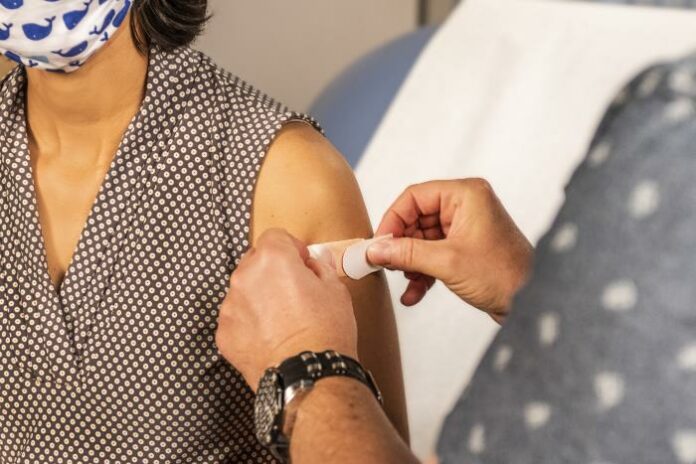At least 393,810 COVID-19 vaccine doses have been wasted in Wisconsin since the vaccines became available in December 2020, according to state DHS numbers reviewed by WisBusiness.com.
That’s about 4 percent of the more than 9.8 million total doses the state has received. The number of doses wasted each week has largely been escalating over the course of the pandemic, according to data provided by the agency in response to a public records request. Dose wastage began ramping up significantly in the spring, when the rate of new vaccinations in Wisconsin saw its steepest decline.
Health officials attribute vaccine waste to vials or syringes being broken or lost, vials being opened but not fully used, and doses being drawn into syringes but not administered. Still, this level of waste isn’t limiting the number of available doses, as the state has plenty of vaccines available according to the Department of Health Services. The agency has been urging providers to prioritize getting people vaccinated over avoiding waste, so some clinics might open a vial only to administer several doses, leading to more waste.
“When faced with situations in which the choice is between opening a vial for a few individuals and assuming waste, or asking that individuals return another day — DHS encourages all vaccinators to prioritize vaccination,” DHS Communications Specialist Jennifer Miller said in an email. “The ultimate goal at this point in the vaccination effort must be ‘no wasted opportunity,’ rather than ‘no wasted doses.’”
The number of wasted doses exceeded 20,000 per week for the first time in mid-October, and has since reached a peak of 28,606 per week in mid-November. It dropped slightly to 19,878 in the last full week of November, the latest period for which these figures were available.
Miller says changes to vial sizes may be contributing to higher levels of waste, as Moderna increased the number of doses per vial from 10 to 14 in response to higher vaccine demand earlier in the pandemic. Now that demand has waned, more doses per vial may be wasted if a clinic doesn’t have enough people show up for a shot.
Since booster recommendations have been expanded to include more age ranges and mix-and-match dosing, providers are ordering and keeping more brands on hand rather than carrying a single type of vaccine. This may be contributing to increased waste as a clinic might have an open vial of Moderna and an open vial of Johnson & Johnson at the same time, depending on which is preferred by the recipient.
“Vaccine wastage may also occur at smaller clinics or in rural communities where there are fewer people or less demand, but vaccinators are leveraging every opportunity to get shots in arms,” Miller said.
Miller also explained that before the pandemic, expired vaccines weren’t counted as wastage in reporting to the Wisconsin Immunization Registry. The new reporting protocol incorporating both wasted and expired vaccines may be contributing to the higher wastage numbers, she said.
Anna Benton, assistant administrator for DHS, said in an emailed letter that “although the number of wasted doses has increased as the rate of vaccination has slowed, DHS continues to trust our network of providers to be good stewards of the vaccine and emphasizes the importance of not wasting any opportunity to vaccinate Wisconsinites.”
Nate Patton is a public health nurse and COVID-19 immunization coordinator for Public Health Madison & Dane County. He says the main strategy vaccinators employ to reduce waste is to hold off on opening vials until they know they’ll be needed.
“Toward the end of the clinic day especially, if we just finished one vial of Pfizer and we know we have three more Pfizer appointments on our schedule, we won’t open the next vial until at least one more Pfizer person comes in,” Patton said in a recent interview. “Because if all three of those are no-shows and we opened the vial expecting them, then we opened the vial for nothing.”
Some of the largest week-over-week increases in waste were seen between late March and May. The number of wasted doses nearly tripled from 1,048 in the week of April 11 to 2,922 in the following week. Less than a month later, the number of wasted doses nearly doubled from 2,681 in the week of April 25 to 4,867 in the following week.
Other weeks were outliers. A total of 708 doses were wasted during the week of Dec. 27, 2020 after just 155 doses had been wasted the week before. After that, the number of wasted doses dropped back down to 132 and didn’t exceed 600 wasted doses per week until late February.
The first COVID-19 vaccine doses were administered in Wisconsin on Dec. 14, 2020. The vaccines were initially available for frontline health care workers and residents of long-term care facilities, until DHS expanded eligibility in mid-January to include police and fire personnel. Later that month, eligibility was expanded once again to include adults aged 65 and older.
On March 1, DHS announced that more groups were eligible for vaccination, including education and child care staff, individuals enrolled in Medicaid long-term care programs, public-facing essential workers such as public transit and grocery store employees, non-frontline essential health care workers, and facility staff and residents of congregate living settings.
Eligibility was again expanded March 22 to include individuals aged 16 and older with a wide array of medical conditions associated with increased risk from the virus. And DHS announced April 5 that COVID-19 vaccines were available to anyone 16 and older. Since then, younger age groups have been authorized to get the vaccine, including children aged 5-11 most recently.
Vaccinators typically receive the Pfizer and Moderna doses frozen, but both of these vaccines can be stored in a refrigerator for about a month, according to storage and handling summaries from the CDC. The Johnson & Johnson vaccine doses usually arrive in a refrigerated shipping container and can be stored until a specific expiration date provided by the manufacturer. Both Pfizer and Moderna vaccines require two doses while the Johnson & Johnson vaccine requires just one.
Once the vaccine is mixed or the vial is punctured, the vaccine can only be used within a certain window before it must be discarded, between two and 12 hours depending on which vaccine it is and the temperature at which it’s stored, the CDC documents show.
Miller noted that waste can happen at “a number of points” given the challenges related to vaccine storage and handling, and “does not mean a provider is negligent or doing a poor job.”
The agency’s approach has shifted over the course of the pandemic as vaccines have become more available. When vaccine inventory was more limited earlier in the pandemic, Patton said vaccinators were requiring appointments, not allowing walk-ins and generally avoiding wasted doses when possible. That changed around May of this year, when DHS issued new guidance to vaccinators “basically saying the focus has shifted, we’re now not focused on wasting doses and we are focused on vaccines in arms,” Patton said.
That change in guidance corresponds with some of the most dramatic increases by percentage in the number of weekly wasted doses.
Still, in order to reduce wasted vaccine doses, DHS has been training vaccinators on how to correctly administer the various COVID-19 vaccines. When vaccinators demonstrate a “pattern of wastage,” the agency reaches out to provide coaching and support.
Miller says providers should “continue to be good stewards of public resources,” though she added “the goal of getting vaccine into the arm of any willing, present individual must take precedence.”
As of Dec. 15, more than 4.7 million Pfizer vaccine doses, 3.1 million Moderna doses and 321,000 Johnson & Johnson doses had been administered in the state, for a total of over 8.2 million COVID-19 vaccine doses. More than 1.3 million booster doses have been administered in Wisconsin.
The DHS site shows at least 61.3 percent of the state’s population has received at least one dose of a COVID-19 vaccine and 57.6 percent has completed the vaccine series.
Since the vaccines were authorized for kids aged 5-11, over 90,000 children in this age range have received at least one dose of a COVID-19 vaccine. That’s 18.5 percent of residents in that age range, while about 57,000 or 11.7 percent are fully vaccinated.
See the breakdown of wasted vaccine doses by week here.
Bite: This story first ran in the Dec. 17 edition of the FRI REPORT.






